Sevilla es Alegria!
Seville, May 19 and 20
We drove into this enchanting city with a mundane initial goal: to find a car wash. Valeriu had suffered the depredations of dusty roads and innumerable bugs, and the flocks of seagulls in Gibraltar delivered the final blow. Something had to be done.
We spotted a lavado automatico at a gas station on the other side of the boulevard and reached it expeditiously thanks to Georgia’s expert maneuvering. Our troubles began at that point, for there were no “entrada” signs for the wash line. We abandoned one approach after running into a line of cars coming toward us and sheepishly circumnavigated the station to join the queue. However, we discovered that Spaniards were equally confused as a counterqueue started to develop in the area we had vacated. When a station employee finally appeared to inform these drivers of the error of their ways, some followed us to the back of the “correct” queue; however, one woman stayed put to enter when her turn was reached. Amazingly, all this maneuvering was accomplished in a relaxed manner with no shouting or honking of horns.
At this and probably most continental car washes, the washing machinery moves while the car remains stationary. (This difference may explain all the problems Secretary Rumsfeld has with “Old Europe.”) While the wash process should take no more time than its U.S. equivalent, the reliance on automation causes delays. As we saw, when something goes awry with the machinery, the driver has to seek the intervention of a station attendant, who finally appears to start the wash process all over again. We spent about an hour at the station, but Valeriu looked great—for a while.
Seville’s architecture has Moorish foundations and many surviving features from Muslim times, but with a heavy overlay of later styles as the city continued to be a vital center after the Christian Reconquest all the way up to the present day. Perhaps the most felicitous example of this mixture of style is the Giralda, the cathedral tower, which is a Moorish minaret with a Renaissance top added by the Christians. Less appealing are the royal palaces (Alcázares Reales), which are a hodgepodge of Moorish and later styles, although there are many attractive features. However, the most welcome aspect of our visit there was an encounter with Marilyn and Steve Pauley, friends from Sun Valley, who were visiting Seville on a Pomona College tour. Did someone say something about a small world?
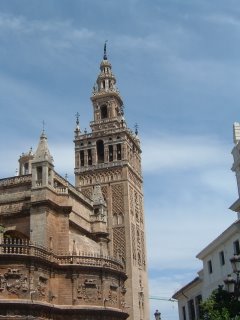
La Giralda
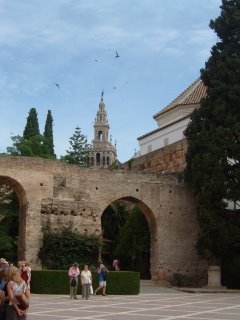
La Giralda as seen from Alcázar
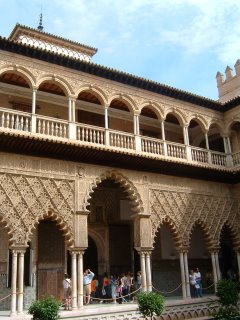
Interior of Alcázar (Renaissance frieze above Moorish arches)
Seville is noted for its religious street processions (pasos), especially in Holy Week but also at other times throughout the year. One started in our neighborhood, accompanied by the River City Boys (and Girls) Band (see below), which played a wailing dirge. The other photo shows kids from the sponsoring parish beginning to lift the float, which featured a draped cross.
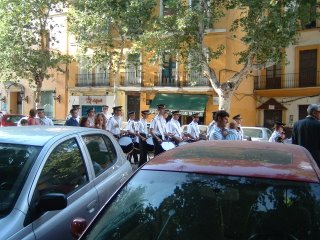
Paso band
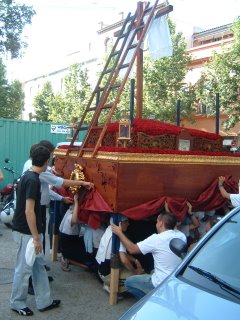
Paso "float"
As reported earlier, we had one tapas evening in Cordoba, but in Seville we went tapeando big time. We spent one pleasant evening at a tapas bar in our neighborhood where the bargirl recommended a fantastic dish (beef tenderloin with sultanas and sherry) that we relished. The next evening we crossed the Guadalquivir River after eight o’clock, when the restaurants and bars start to open, to try tapas and vino tinto de verano at two different establishments, where we watched the sun go down. Here, we had tasty fish, meat, and salad tapas, topped off with Tocino del Cielo, a caramel flan straight from the convent. The tradition of convent-made sweets continues in Spain, and we have had several samples, beginning with marzipan in Toledo, where it originated.
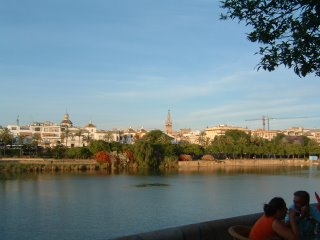
Seville at beginning of tapas evening
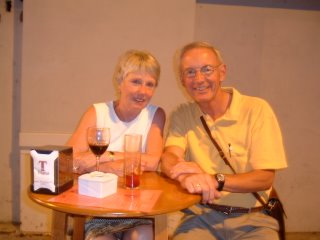
Georgia and Todd tapeando
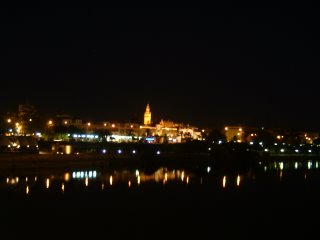
Seville at end of tapas evening
